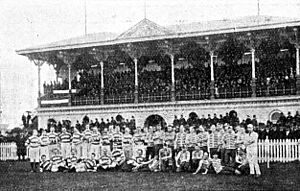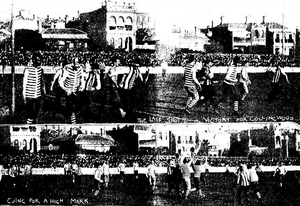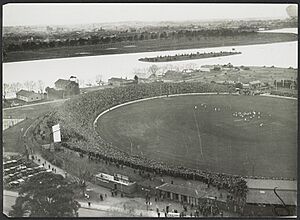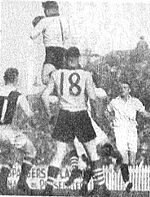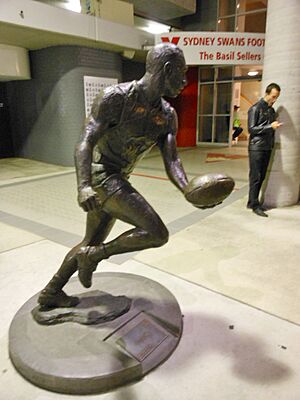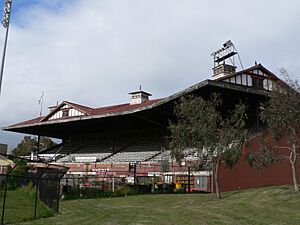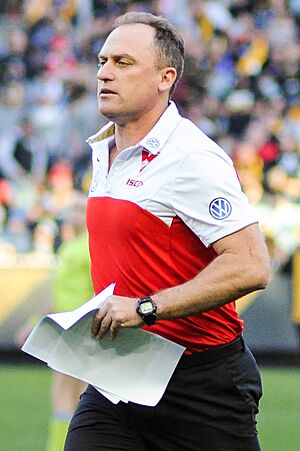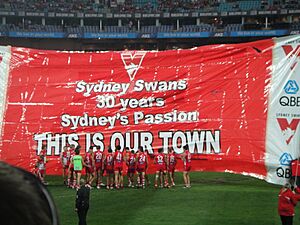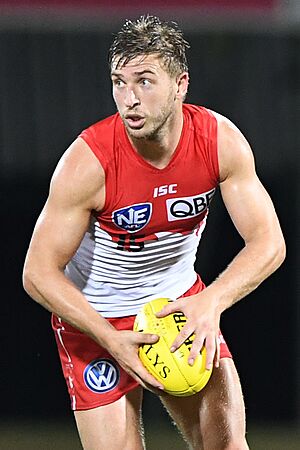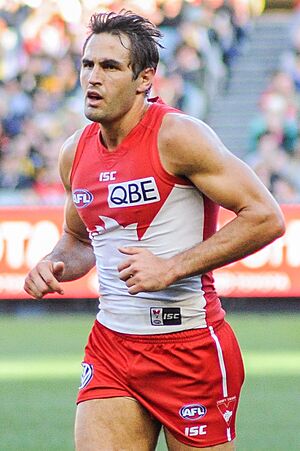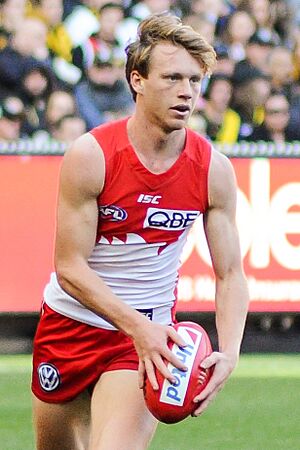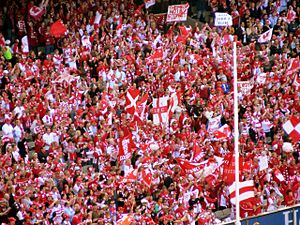Sydney Swans facts for kids
Quick facts for kids Sydney Swans |
||||
|---|---|---|---|---|
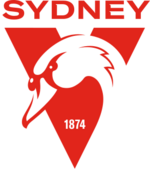 |
||||
| Names | ||||
| Full name | Sydney Swans | |||
| Former name(s) | South Melbourne Football Club (1874–1981) The Swans (1982) |
|||
| Nickname(s) | Swans, Swannies, Bloods | |||
| 2024 season | ||||
| After finals | Runners-up | |||
| Home-and-away season | 1st | |||
| Leading goalkicker | Tom Papley (37 goals) | |||
| Club details | ||||
| Founded | 19 June 1874 | |||
| Colours | Red White | |||
| Competition | AFL: Senior men AFLW: Senior women VFL: Reserves men VFLW: Reserves women |
|||
| Coach | AFL: John Longmire AFLW: Scott Gowans VFL: Damian Truslove |
|||
| Captain(s) | AFL: Callum Mills AFLW: Chloe Molloy, Lucy McEvoy VFL: William Collis |
|||
| Premierships | VFL/AFL (5)
|
|||
| Ground(s) | AFL: Sydney Cricket Ground (48,000) AFLW: Henson Park (30,000) North Sydney Oval (10,000) VFL: Sydney Cricket Ground, Tramway Oval (1,000) |
|||
| Former ground(s) | Lakeside Oval (1874–1981) Stadium Australia (2002–2015) |
|||
| Training ground(s) | Outdoor: Sydney Cricket Ground, Tramway Oval, Moore Park Indoor: Royal Hall of Industries, Moore Park |
|||
| Uniforms | ||||
|
||||
The Sydney Swans are a professional Australian rules football club based in Sydney, New South Wales. The men's team plays in the Australian Football League (AFL). The women's team competes in the AFL Women's (AFLW). The Swans also have a men's reserve team in the Victorian Football League (VFL). The Sydney Swans Academy helps develop young players.
The club started on March 21, 1873, as the South Melbourne Football Club. They played at Lakeside Oval in Albert Park. The club joined the Victorian Football Association (VFA) in 1878. Later, they became a founding member of the Victorian Football League (VFL) in 1897. They were first known as the "Bloods" because of their red uniforms. In 1933, they became known as the "Swans" after many players from Western Australia joined. The black swan is the symbol of Western Australia.
In 1982, the club moved from Victoria to New South Wales. This made them the first professional Australian football club to move interstate. They were first called "The Swans" in Sydney. In 1983, they officially became the "Sydney Swans".
The Swans have a big rivalry with the Greater Western Sydney Giants. They play against them in the Sydney Derby. The Swans train at Moore Park. Their main home ground for men's games is the Sydney Cricket Ground. The Swans have won five VFL/AFL championships. These were in 1909, 1918, and 1933. They then had a long wait of 72 years without a championship. This was the longest drought in the league's history. The drought ended with a win in 2005. They won another championship in 2012. They have won five Grand Finals and lost twelve.
The Swans are one of the most popular clubs in the AFL. In 2021, they had over a million fans.
Contents
- Club History
- Early Years: 1873–1896
- VFL Era: 1897–1945
- Tough Times: 1946–1981
- Moving to Sydney: 1982
- The Sydney Swans Era: 1982–Present
- Club Identity
- Club Rivalries
- Men's Team
- Women's Team
- Reserves Team
- Sydney Swans Academy
- Club Operations
- Supporter Base
- Club Achievements
- Club Records
- Activism
- See also
Club History
Early Years: 1873–1896
The club began on March 21, 1873. A meeting was held to create the South Melbourne Football Club. The club officially started on June 19, 1874. It was first called "Cecil Football Club" but changed to "South Melbourne Football Club" a few weeks later. Their home ground was Lake Oval in Albert Park.
In 1880, South Melbourne joined with the Albert-park Football Club. They kept the name South Melbourne and adopted the red and white colors from Albert-park. They were nicknamed the "Bloods" because of the bright red stripe on their white uniforms. After this, they became a very strong team in Melbourne.
VFA Success
South Melbourne won five VFA championships in their first ten years. They won in 1881, 1885 (undefeated), 1888, 1889, and 1890. They were also runners-up several times. In 1886, a game against Geelong was very popular because both teams were undefeated.
The club also traveled to New South Wales in 1883. They played and won against teams in Newcastle and Sydney. In 1889, they played against a touring Maori team from New Zealand.
In 1896, South Melbourne played in the first VFA Grand Final against Collingwood. Collingwood won the game. This was South Melbourne's last VFA match. The next year, they became one of the eight founding clubs of the new Victorian Football League.
VFL Era: 1897–1945
South Melbourne was one of the first clubs in the Victorian Football League (VFL) in 1897.
Championship Wins
The club won VFL championships in 1909, 1918, and 1933. In 1932, the red stripe on their uniform changed to a red "V" shape.
The 1930s were a very successful time for the club. They had many new players from other states. They reached the Grand Final four times in a row from 1933 to 1936. They won the championship in 1933. These new players were called South Melbourne's "Foreign Legion".
In 1935, star player Bob Pratt missed the Grand Final after being hit by a truck. The truck driver was a South Melbourne fan!
The team became known as the Swans during this time. A journalist suggested the name in 1933. It was because many Western Australian players were in the team. The black swan is the symbol of Western Australia. The name also fit because of the swans in nearby Albert Park Lake.
In 1945, South Melbourne reached the Grand Final again. They played against Carlton. This game was called "the Bloodbath" because of a big fight between players. Carlton won the game. After this, South Melbourne had many difficult years.
Tough Times: 1946–1981
After World War II, South Melbourne struggled a lot. Many people moved out of their traditional recruiting area. The club often finished low on the ladder. They only made the finals twice between 1945 and 1981. They also finished last three times. Between 1972 and 1973, they lost 29 games in a row.
Moving to Sydney: 1982

The VFL wanted to grow the sport in Sydney. They had played exhibition matches there since 1903. In 1979, two VFL games at the Sydney Cricket Ground drew large crowds. The VFL saw that Sydney had a lot of potential for a new team.
In 1981, the South Melbourne club decided to move to Sydney. They wanted to find new fans and become more stable. The club had been losing money for several years. The move was approved by the VFL.
Many fans in Melbourne were against the move. A group called "Keep South at South" tried to stop it. But the club's new board, which supported the move, was put in place. The players also wanted the club to move to Sydney for the long term.
The Sydney Swans Era: 1982–Present
In 1982, the club played all its home games at the Sydney Cricket Ground. They were first called "the Swans". In 1983, they officially became the "Sydney Swans".
Edelsten Era and New Stadium
In 1985, Geoffrey Edelsten bought the Swans. He brought in new players and a new coach, Tom Hafey. Players like David Bolton, Bernard Toohey, and Greg Williams joined the team. Other stars like Gerard Healy, Merv Neagle, and Paul Morwood also came.
The Swans became a flashy and exciting team. Player Warwick Capper was very famous for his unique style and amazing high marks. He kicked 103 goals in 1987. The Swans made the finals for the first time since moving to Sydney. Crowds grew to about 25,000 per game. Edelsten also introduced cheerleaders called "Swanettes," but they didn't last long.
In 1987, the Swans scored over 200 points in two games in a row. This is a very rare achievement. The club moved to the new Sydney Football Stadium in 1988.
Difficult Years: 1988–1994
After the Edelsten era, the club faced tough times. Coach Tom Hafey was replaced. Star players like Warwick Capper left. Many other players also departed. The team struggled on the field. Attendances dropped below 10,000. The Swans finished last three years in a row from 1992 to 1994.
The AFL considered merging or moving the club. But they decided to help the Swans stay in Sydney. The team was led by inspiring captains like Dennis Carroll and Paul Kelly. Ron Barassi became coach in 1993 and helped improve the team.
Tony Lockett and Grand Final Return: 1995–2001
A big moment for the club was signing champion player Tony "Plugger" Lockett in 1995. Lockett became a hero in Sydney. He helped the Swans become a strong team.
In 1995, Paul Kelly won the Brownlow Medal, the league's top individual award. Rodney Eade became coach in 1996. The Swans finished first in the regular season. They reached the Grand Final for the first time since 1945. Lockett kicked a winning goal after the siren in a thrilling preliminary final. However, the Swans lost the Grand Final to North Melbourne.
The Swans made the finals in four of the next five years. In 1999, Tony Lockett kicked his record-breaking 1300th goal.
Rebuilding and Finals: 2002–2004
Former Swans player Paul Roos became coach in 2002. He helped the team become successful. The Swans also started playing some home games at Stadium Australia (ANZ Stadium) for bigger crowds. A game against Collingwood in 2003 drew over 72,000 fans.
The Swans signed another strong forward, Barry Hall, from St Kilda. He became a popular player and a leader for the club. The Swans focused on recruiting players who wanted a fresh start at the club. This strategy helped them build a strong team.
Championship Glory: 2005
In 2005, the Swans played with a strong defense. Coach Paul Roos believed this style helped win championships.
Nick Davis! Nick Davis! I don't believe it! I see it, but I don't believe it!
Cox throws it onto the left, one last roll of the dice for the Eagles – Leo Barry, you star!...(Siren in background)...The longest Premiership drought in football history is over! For the first time in 72 years, the Swans are the champions of the AFL!"
The Swans finished third in the regular season. They lost their first final but then had a dramatic win against Geelong. Nick Davis kicked four goals in the last few minutes to win the game. They then beat St Kilda to reach the Grand Final.
The Swans faced the West Coast Eagles in the AFL Grand Final on September 24, 2005. They won by just four points! In the final seconds, Leo Barry took a crucial mark to stop the Eagles. This win ended the Swans' 72-year championship drought. It was their first championship since moving to Sydney.
| 2005 AFL Grand Final | G | B | Total |
| Sydney Swans | 8 | 10 | 58 |
| West Coast Eagles | 7 | 12 | 54 |
| Venue: Melbourne Cricket Ground | Crowd: 91,898 | ||
Sydney celebrated with a parade down George Street. The Lord Mayor gave the team the key to the city. The Swans flag also flew on the Sydney Harbour Bridge.
Grand Final Loss: 2006
In 2006, the Swans started slowly. They reached the Grand Final again, facing the West Coast Eagles. This time, the Eagles won by just one point.
The rivalry between the Swans and Eagles became very famous. Six games between 2005 and 2007 were decided by very small margins.
Finals Appearances: 2007–2010
Sydney made the finals in 2007, 2008, and 2010. In 2009, they missed the finals for the first time since 2002. Many key players left the club after the 2009 season. The 2010 season was the last for coach Paul Roos and captain Brett Kirk.
John Longmire Era: 2011–Present
John Longmire became the new coach in 2011. The Swans made the finals again. They had a big upset win against Geelong, who had won 29 games in a row at their home ground.
2012: Championship Year
The 2012 season started with the first Sydney Derby against the new GWS Giants. Sydney won the game. The Swans had a nine-game winning streak during the season. They finished third.
The Swans won their qualifying final and preliminary final. They reached their first Grand Final since 2006.
In the Grand Final, the Swans beat Hawthorn by ten points. Nick Malceski kicked a goal in the final seconds to seal the win. This was the Swans' fifth championship. Ryan O'Keefe was named the best player in the Grand Final.
In 2013, many key players were injured. But the team still reached the preliminary finals.
2014–2016: Grand Final Losses
The 2014 season started with some losses. But the Swans then won twelve games in a row. They finished first in the regular season for the first time in 18 years. They reached the 2014 AFL Grand Final. They were favorites to win. However, Hawthorn dominated the game and beat the Swans by 63 points. This was Sydney's biggest Grand Final loss.
In 2015, the Swans had a good start but then struggled. They missed the preliminary final for the first time since 2011.
The Swans started the 2016 season very strong. They won their first three games by large margins. They finished first in the regular season again. In the finals, they lost to GWS in a close game. But they bounced back to beat Adelaide and Geelong. This led them to their third Grand Final in five years. They played against the Western Bulldogs. The Bulldogs pulled away in the final quarter and won. This was the Swans' second Grand Final loss in three years.
In 2017, the Swans had a very tough start, losing their first six games. But they made an amazing comeback, winning 13 of their next 15 games. They became the first team to reach the finals after starting 0–6. They won their first final but then lost to Geelong.
In 2018, the Swans had an up-and-down season. They lost many games at home. They made the finals but were beaten by GWS.
The Swans missed the finals in 2019 for the first time in ten years. They finished 15th.
2016–Present: Pride Games
In 2015, the Swans played a special "Pride Game" to support the LGBTQIA+ community. This became an annual event. The Swans and St Kilda now play these games each year.
2020s: Return to Finals
In 2020, the season was interrupted. The Swans won only five games and missed the finals again. This was their lowest finish ever.
In 2021, the Swans improved greatly. They had a strong start and finished sixth. They lost a close final game to GWS by one point.
In 2022, the Swans continued their strong performance. They won five of their first six games. Lance Franklin kicked his 1000th career goal in Round 2, leading to a huge celebration on the field. They finished in the top four.
In the 2022 finals, the Swans beat Melbourne. They then beat Collingwood by one point in the preliminary final. This sent them to their fourth Grand Final in 12 years. On September 24, the Swans lost the 2022 AFL Grand Final to Geelong.
In 2023, the Swans started well but then had a slump. They recovered to win six games in a row and made the finals.
In 2024, the Swans finished first in the regular season. They won the minor premiership. They beat GWS and Port Adelaide in the finals. This qualified them for their seventh Grand Final of the 21st century.
Club Identity
The club's nickname, the Swans, came from a journalist in 1933. It was inspired by the many Western Australian players in the team. The black swan is the state symbol of Western Australia. The Chicago Swans club is linked to the Sydney Swans and has a similar logo.
Uniforms
The Swans' home uniform is white with a red back. It has a red shape on the top that looks like the Sydney Opera House. This design started in 1987. The club's main sponsor is QBE Insurance. Since 2004, the initials 'SMFC' are on the back of the collar to honor their past as South Melbourne Football Club.
Nike makes the Swans' uniforms.
Uniform Evolution
| Uniform Evolution | ||
| Design | Period | Description and history |
|---|---|---|
|
|
1874–1879 | The club's original uniform. It had blue and white hoops with blue shorts. |
|
|
1880–1904 | The same hoop design, but with red and white colors. It still had blue shorts. |
|
|
1905–06 | A red and white uniform with vertical stripes. A special version was worn in 1996. |
|
|
1907–11 1913–19 1923–31 |
A white uniform with a red stripe (sash) from the left shoulder to the right hip. A special version was worn in 2018. |
|
|
1912 | A reversed version of the sash uniform. |
|
|
1920–1922 | A full red uniform with white shorts. It had the letters SMFC on the front. |
|
|
1932–74 | A white uniform with a red "V" shape. It was worn with black shorts. |
|
|
1975–86, 2021–present | The same "V" design, but with red shorts. It is often used for special heritage games. Since 2022, it is also used as an away uniform. |
|
|
1987–present | A white uniform with a red panel at the top. The red panel shows the Sydney Opera House. It is worn with red shorts. |
Club Song
The club song is Cheer, Cheer The Red and The White'. It uses the tune of the Victory March. This song is from the University of Notre Dame in the US. In 2021, the club changed a line in the song to be more inclusive. "while her loyal sons are marching..." became "while our loyal Swans are marching...".
Home Ground and Training Base
The club's first home ground was Lakeside Oval in Melbourne.
Since 2016, the Swans play all their home games at the Sydney Cricket Ground. It can hold 48,000 people. The Swans have played there since they moved to Sydney in 1982. From 2002 to 2015, they also played some games at Stadium Australia (ANZ Stadium).
The club trains at the SCG and the nearby Tramway Oval. In 2018, the club announced plans to move its offices and indoor training to the Royal Hall of Industries. This new facility opened in June 2023. It has an indoor training field, gym, and other modern facilities.
Club Rivalries
Greater Western Sydney
The Sydney Derby started in 2012 when the GWS Giants joined the AFL. The Swans play against them twice each season. The best player in each derby game wins the Brett Kirk Medal.
The Swans won most of the early derby games. But now the rivalry is much closer. The Giants have won three of their four finals matches against the Swans.
West Coast Eagles
The Swans had a famous rivalry with the West Coast Eagles between 2005 and 2007. Six games in a row, including two Grand Finals, were decided by less than a goal. The Swans won the 2005 Grand Final by four points. The Eagles won the 2006 Grand Final by one point.
Hawthorn
The rivalry with Hawthorn became strong because of two Grand Finals. The Swans beat Hawthorn in 2012 to win the championship. In 2013, Hawthorn player Lance Franklin moved to the Swans. In 2014, the Swans and Hawthorn met in the Grand Final again. Hawthorn won by a large margin. Their games since then are often very close.
Men's Team
Current Squad
| Senior list | Rookie list | Coaching staff | |||||||
|---|---|---|---|---|---|---|---|---|---|
|
|
|
Head coach
Assistant coaches
Updated: 15 June 2025 |
||||||
Women's Team
The Sydney Swans women's team started in 2016 for exhibition games. They joined the AFLW in 2022. They had the most members in the AFLW in 2022. Even though they finished last in their first season, they had the 4th highest average home attendance. They play at North Sydney Oval and Henson Park.
Current Squad
| Senior list | Rookie list | Coaching staff | |||||||
|---|---|---|---|---|---|---|---|---|---|
|
|
|
Head coach
Assistant coaches
Updated: 15 June 2025 |
||||||
Club Champion
| Season | Winner | Runner-up | Third place | Ref. |
|---|---|---|---|---|
| 2022 (S7) | Cynthia Hamilton | Montana Ham | Sofia Hurley | |
| 2023 | Laura Gardiner | Chloe Molloy | Ally Morphett |
Reserves Team
| Sydney | ||
|---|---|---|
| Names | ||
| Full name | Sydney Swans Limited | |
| Former name(s) | South Melbourne reserves (1925–1982) |
|
| Former nickname(s) | Redbacks | |
| 2023 season | ||
| Home-and-away season | 18th | |
| Club details | ||
| Founded | 27 March 1900 | |
| Competition | Victorian Football League | |
| Coach | Damian Truslove | |
| Captain(s) | Adam Gulden | |
| Premierships | AFL Canberra (4)
|
|
| Ground(s) | Sydney Cricket Ground & Tramway Oval (1,000) | |
| Uniforms | ||
|
||
The Sydney reserves team plays in the Victorian Football League since 2021.
History
The South Melbourne Football Club formed the South Melbourne Juniors in 1900. They joined the Metropolitan Junior Football Association.
Later, the team played in the VFL seconds competition until 1999. They did not win any championships in this league.
In 2000, the Sydney reserves, called the Redbacks, joined the Sydney AFL. They were too strong for this league. From 2003, the Sydney reserves played in the AFL Canberra league. They won four championships in a row from 2005 to 2008.
In 2011, the Swans reserves team joined the North East Australian Football League (NEAFL). They often played before the senior AFL games. They reached the NEAFL Grand Final five times but never won.
After the NEAFL ended in 2020, the Sydney reserves joined the Victorian Football League.
Sydney Swans Academy
The Sydney Swans Academy helps develop young players for the club. It started in 2010. It is one of four academies in the northern states of Australia.
The Academy has 72 staff members. They work in 9 facilities and train 550 young players from age 10. They have training centers in different regions of New South Wales.
The Academy's U16 and U18 teams play in national championships. The Swans Academy also joined the Talent League in 2019.
Club Operations
Leadership
The AFL Commission owns most of the club. They choose seven of the nine board members. Club members elect the other two.
Directors:
- Andrew Pridham (chairman)
- Andrew Ireland
- Sam Mostyn
- Robert Morgan
- Greg Paramor
- Darren Steinberg
- Leo Barry
- Alexandra Goodfellow
- Brian Tyson
CEOs:
- Tom Harley (current)
- Andrew Ireland
- Myles Baron-Hay
- Phil Mullen
- Colin Seery
- Kelvin Templeton
- Jordan Sembel
Sponsors
Current Major Sponsors
As of November 2023, the club's main sponsors are:
- realestate.com.au
- Volkswagen
Premier Partners
- Nike
- Qatar Airways
- HSBC
- Carsales
- Origin Energy
- Channel 7
- Independent Reserve
- Transport for NSW
- Fiserv
- McDonalds
- Office of Responsible Gambling
- Sydney Children's Hospitals Foundation
Supported Charities
- Wally Jackson Research Fund
- Sydney Australian Football Foundation (SAFF)
Supporter Base
Many fans in Melbourne were sad when the club moved. But the Sydney Swans have built a large fan base in Sydney. The number of fans and members grew a lot when Tony Lockett played. This was also helped by problems in the rival rugby league sport. The Swans still have many fans in Victoria.
In 2024, the Sydney Swans had their highest home attendance ever. An average of 38,202 fans came to each home game. The club also reached a new membership record of 73,757 in September 2024.
The Black Swans is a supporters club for First Nations fans. It was started by actress Lillian Crombie.
According to Roy Morgan Research, the Swans have been the most supported AFL club since 2004.
The Rainbow Swans is an official supporter group for the LGBTQIA+ community.
Legend: Premiers Grand Finalist Finals Wooden spoon
| Year | Members | Finishing position | Average Home crowd |
|---|---|---|---|
| 1982 | 7th | 15,993 | |
| 1983 | 11th | 12,025 | |
| 1984 | 2,750 | 10th | 12,497 |
| 1985 | 2,777 | 10th | 10,137 |
| 1986 | 4,927 | 4th | 25,819 |
| 1987 | 3,594 | 4th | 22,032 |
| 1988 | 2,516 | 7th | 12,311 |
| 1989 | 2,631 | 7th | 12,317 |
| 1990 | 2,624 | 13th | 9,178 |
| 1991 | 2,907 | 12th | 11,521 |
| 1992 | 3,020 | 15th | 9,881 |
| 1993 | 3,097 | 15th | 9,423 |
| 1994 | 3,327 | 15th | 9,813 |
| 1995 | 6,088 | 12th | 15,949 |
| 1996 | 9,525 | 2nd | 24,996 |
| 1997 | 22,109 | 7th | 36,612 |
| 1998 | 31,089 | 5th | 31,549 |
| 1999 | 31,175 | 8th | 30,586 |
| 2000 | 30,177 | 10th | 25,308 |
| 2001 | 28,022 | 7th | 27,556 |
| 2002 | 27,755 | 11th | 25,270 |
| 2003 | 21,270 | 3rd | 32,244 |
| 2004 | 25,010 | 5th | 30,964 |
| 2005 | 24,955 | 1st | 31,516 |
| 2006 | 30,382 | 2nd | 32,877¹ |
| 2007 | 28,764 | 7th | 35,632¹ |
| 2008 | 26,721 | 6th | 32,834 |
| 2009 | 26,269 | 12th | 30,506 |
| 2010 | 28,671 | 5th | 31,586 |
| 2011 | 27,106 | 6th | 26,615 |
| 2012 | 29,873 | 1st | 27,663 |
| 2013 | 36,358 | 4th | 29,104 |
| 2014 | 40,126 | 2nd | 32,579 |
| 2015 | 48,836 | 5th | 32,217 |
| 2016 | 56,523 | 2nd | 33,425 |
| 2017 | 58,838 | 5th | 34,475 |
| 2018 | 60,934 | 7th | 32,575 |
| 2019 | 61,912 | 15th | 31,070 |
| 2020 | 48,322 | 16th | 3,421 |
| 2021 | 50,144 | 6th | 21,209 |
| 2022 | 55,394 | 2nd | 29,424 |
| 2023 | 65,332 | 8th | 32,824 |
| 2024 | 73,757 | 1st | 38,202 |
Club Achievements
Team Awards
| Championships | |||
| Competition | Level | Wins | Years Won |
|---|---|---|---|
| Australian Football League | Seniors | 5 | 1909, 1918, 1933, 2005, 2012 |
| Victorian Football Association (1879–1896) | Seniors | 5 | 1881, 1885, 1888, 1887, 1890 |
| AFL Canberra (2003–2010) | Reserves | 4 | 2005, 2006, 2007, 2008 |
| AFL Under-19s | Under 19s | 1 | 1956 |
| Other Titles | |||
| VFL Night Series | Seniors | 3 | 1956, 1957, 1960 |
| AFC Night Series | Seniors | 1 | 1982 |
| McClelland Trophy | Various | 3 | 1996, 2014, 2016 |
| Finishing Positions | |||
| Australian Football League | Minor premiership | 10 | 1909, 1912, 1918, 1935, 1936, 1945, 1996, 2014, 2016, 2024 |
| Grand Finalist | 14 | 1899, 1907, 1912, 1914, 1934, 1935, 1936, 1945, 1996, 2006, 2014, 2016, 2022, 2024 | |
| Wooden spoons | 11 | 1903, 1922, 1938, 1939, 1962, 1971, 1973, 1975, 1992, 1993, 1994 | |
| AFL Women's | Minor premiership | 0 | |
| Grand Finalist | 0 | ||
| Wooden spoons | 1 | 2022 (S7) | |
Individual Awards
Bob Skilton Medal (Club Best and Fairest)
Brownlow Medal (League Best and Fairest)
- Herbie Matthews – 1940
- Ron Clegg – 1949
- Fred Goldsmith – 1955
- Bob Skilton – 1959, 1963, 1968
- Peter Bedford – 1970
- Graham Teasdale – 1977
- Barry Round – 1981
- Greg Williams – 1986
- Gerard Healy – 1988
- Paul Kelly – 1995
- Adam Goodes – 2003, 2006
Norm Smith Medal (AFL Grand Final Best on Ground)
- Ryan O'Keefe – 2012
Leigh Matthews Trophy (AFLPA Most Valuable Player)
- Gerard Healy – 1988
Coleman Medal (Leading Goal Kicker)
- Tony Lockett – 1996, 1998
- Lance Franklin – 2014, 2017
AFL Rising Star (Best Player Under 21)
- Adam Goodes – 1999
- Dan Hannebery – 2010
- Callum Mills – 2016
Team of the Century
Sydney announced its team of the century on August 8, 2003:
Hall of Fame
| Sydney Swans | |||||||||||||||||||||||||||||||||||||||||||||
|---|---|---|---|---|---|---|---|---|---|---|---|---|---|---|---|---|---|---|---|---|---|---|---|---|---|---|---|---|---|---|---|---|---|---|---|---|---|---|---|---|---|---|---|---|---|
| Hall of Fame | |||||||||||||||||||||||||||||||||||||||||||||
Individuals
|
Club Records
- Most games – Adam Goodes (372)
- Most goals – Bob Pratt (681)
- Most goals in a match – Tony Lockett (16), Round 19, 1995 vs Fitzroy
- Most goals in a season – Bob Pratt (150) in 1934
- Most games coached – John Longmire (300)
- Highest score – 36.20 (236) vs Essendon 11.7 (73), Round 17, 1987
- Lowest score – South Melbourne 0.5 (5) vs Carlton 3.6 (24), Round 8, 1899
- Lowest score since 1919 – South Melbourne 1.9 (15) vs Geelong 8.9 (57), Round 16, 1964
- Highest losing score – South Melbourne 24.10 (154) vs Melbourne 24.23 (167), Round 1, 1979
- Lowest winning score – South Melbourne 2.3 (15) vs Melbourne 1.7 (13), Round 6, 1898
- Lowest winning score since 1919 – South Melbourne 4.15 (39) vs Fitzroy 4.12 (36), Round 4, 1919
- Since 1920 – South Melbourne 5.11 (41) vs St. Kilda 5.9 (39), Round 16, 1948
- Biggest Winning Margin
- As South Melbourne – (171 points) – South Melbourne 29.15 (189) vs St. Kilda 2.6 (18), Round 12, 1919
- As Sydney Swans – (171 points) – Sydney Swans 31.19 (205) vs West Coast Eagles 5.4 (34), Round 15, 2023
- Biggest Losing Margin – (165 points) – South Melbourne 2.7 (19) vs Essendon 28.16 (184), Round 18, 1964
Activism
Same Sex Marriage
During the Australian Marriage Law Postal Survey, the Sydney Swans supported the "Yes" vote.
Voice to Parliament
The Sydney Swans support the Voice to Parliament. This is a proposed advisory body for Aboriginal and Torres Strait Islander people in Australia.
See also
 In Spanish: Sydney Swans Football Club para niños
In Spanish: Sydney Swans Football Club para niños
- Australian rules football in New South Wales
- Sport in Australia
- Sport in New South Wales


